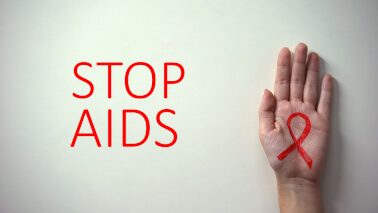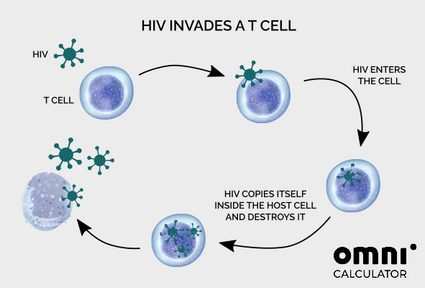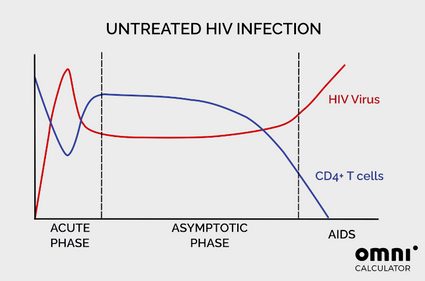Denver HIV Risk Score Calculator
The Denver HIV risk score calculator is your ally when it comes to the quick identification of patients with a high HIV risk. You'll find information on how, when, and why to use the Denver HIV risk score (or DHRS) in the text.
The page also provides notes for patients — you will know what is HIV exactly, be given an AIDS definition as well as the AIDS symptoms. By knowing high-risk behaviors for HIV and the HIV transmission risk for various activities, you'll know how to protect yourself from potential infection. Let's fight HIV/AIDS together.

We try our best to make our Omni Calculators as precise and reliable as possible. However, this tool can never replace a professional doctor's assessment. If any health condition bothers you, consult a physician.
Why do we use the Denver HIV Risk Score?
If you are a doctor, you probably think it's a good idea for everyone to get tested for HIV at least once in their lifetime (including yourself!). And that is medically justified, but in real life, you often have to deal with a lack of time per patient, a lack of available tests, and individual resistance.
After finding that nontargeted HIV testing , the search for a more accurate tool began.
This is why the Denver HIV risk score — or DHS — was created. It's a relatively new concept from the 2000s, but it has been and . Even and is a good alternative. Using the scale, to identify the same number of patients infected with HIV as nontargeted screening, which shows it has an excellent cost-effect ratio as well.
All this makes the Denver HIV risk score calculator a useful tool, ready to be used in emergency departments, outpatient clinics, and urgent care. What is more, it requires nothing but an honest conversation.
How to use the Denver HIV Risk Score Calculator?
Our calculator is easy to implement during regular patient visits. Just follow these steps:
- Fill in the basic pieces of information about your patient — their sex and age.
- Then ask them about their sexual practices. This question was abbreviated in the shortened DHRS version — if they have sex with a male, add 22 points; if they don't, don't add any points, with no further questions. However, if you choose to use the original version, pick their practice that yields the highest score.
- Choose if a patient presents other high-risk behaviors for HIV, like injection drug use addiction.
- Choose the patient's self-reported race. You do not have to fill this question, though, as it's optional.
You'll see the score and short description below the calculator. A good rule to remember is that anyone with moderate or higher risk should get tested at least once in their lifetime.
What is HIV? HIV/AIDS definition
HIV stands for Human Immunodeficiency Virus. HIV belongs to Lentivirus genus and is believed to have been transferred from chimpanzees to humans about one hundred years ago.
When entering the body, HIV attacks the cells in the immune system, such as helper T cells (Th cells, a lymphocyte subtype), macrophages, and dendritic cells. Helper T cells are also called CD4+ cells because of the CD4+ receptor found on the cell surface. The virus enters the cell and replicates inside of it — as a result, the cell dies, and new virus copies are released. Over time, the number of helper T cells drops, which causes immune system failure.

Someone infected with HIV may not even present the initial symptoms of HIV/AIDS. If they do, however, they usually come in the form of an influenza-like illness, with fever, enlarged lymph nodes, and weakness.
After around two weeks of cold-like symptoms, a years-long (usually 6-10 years) asymptomatic phase begins. Near the end of this period, patients may experience symptoms like fatigue, fever, loss of weight, shingles, thrush, or multiple cases of pneumonia — signs of decreased immunity. CD4+ cells slowly reduce in number until they reach the critical point where the body can no longer defend itself against common pathogens.
Then the patient starts to catch opportunistic diseases — diseases from germs that are no danger to healthy people. This late stage of HIV infection is exactly the AIDS definition — AIDS stands for Acquired ImmunoDefficiency Syndrome.

Once a person gets HIV, they have it forever. Today, we have drugs that can slow down the disease's progression so effectively that an infected person can lead an almost completely normal life. Without medication, AIDS is the final stage of the infection, and AIDS symptoms — or, more correctly, the symptoms of AIDS-related diseases — are the cause of death.
That's why it is crucial to know what is HIV, what are the high-risk behaviors for HIV, and to get tested when you're in doubt or if you've never had one before.
AIDS symptoms
As explained in the paragraph above, the AIDS definition is that it is a late stage HIV infection. AIDS can be recognized by the presence of opportunistic infections and AIDS-related cancers (sometimes called sentinel diseases, as they indicate HIV infection) and by immune criterion — less than 200 CD4+ cells/mm³. Although they're individual diseases, they're caused by immune deficiency, thus we can call them AIDS symptoms.
HIV/AIDS-related diseases are not the same thing. HIV-related diseases are more a signal to test the patient, whereas AIDS-related diseases indicate its progression.
Some examples of HIV/AIDS-related diseases (most of them are opportunistic infections) include:
- Recurring bacterial pneumonia;
- Tuberculosis;
- Thrush of the esophagus, trachea, bronchii or lungs;
- Coccidioidomycosis, cryptococcosis, or histoplasmosis — when found outside of the lungs;
- Mycobacterium genus infection — when found outside of the lungs;
- Invasive H. simplex (yes, a common cold sore virus) infection;
- Progressive multifocal leukoencephalopathy;
- Cytomegalovirus retinitis;
- Changes in the blood morphology: anemia, decreased level of neutrophils and thrombocytes;
- Cancers: Kaposi sarcoma, invasive cervical cancer, some types of lymphoma;
- HIV-related encephalopathy; and
- HIV wasting syndrome.
What a patient experiences will depend on their immunological state and the measures they take to control the disease. Without proper medical care, symptoms can be severe and might include:
- Rapid weight loss;
- Long-lasting diarrhea;
- Skin problems, skin infections;
- Night sweats, fever; and
- Extreme fatigue.
Interested in immunity disorders? Check the rest of our tools:
- MIPI calculator (for mantle cell lymphoma);
- Absolute neutrophil count calculator; and
- Absolute lymphocyte count calculator.
Route of infection and HIV transmission risk; high-risk behaviors for HIV
After entering an individual, the HIV virus stays in the person's blood]. It can be further transferred to another person if there is blood-to-blood contact. However, HIV can be transferred by other routes. You can get infected by having sexual contact with an ill person. HIV can also transfer vertically, meaning it can travel through the placenta during pregnancy and infect the unborn child.
Let's sum up the high-risk behaviors for HIV. We cannot state exactly how dangerous each behavior is. Still, there are many factors and preventive measures that you should always consider if you are in a potentially dangerous situation.
1) Blood contact
- Like sharing needles/syringes when injecting drugs, but also contact with the blood in accidents;
- The best way to prevent HIV infection is to not take intravenous drugs. However, if this is not possible — use disposable syringes and needles and never share them with anybody — don't take anyone's needles or syringes; and
- About 10% of the new HIV/AIDS diagnoses in the USA are attributed to IV drug use.
2) Sexual contact
- The most common way to transmit HIV is via anal sex, but vaginal sex poses a risk as well;
- There is little or no risk of getting the virus from oral sex;
- HIV transmission risk drops drastically if you use a condom and lubricant (they don't provide you 100% protection); and
- Other STDs (sexually transmitted diseases) or lesions present in the intimate area increase the risk.